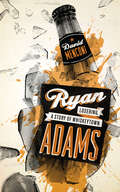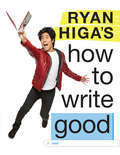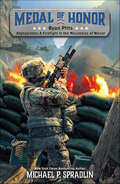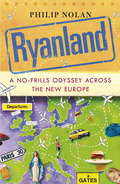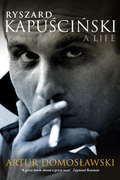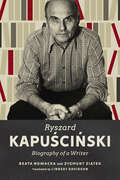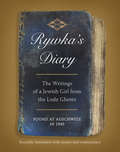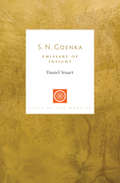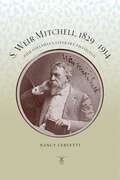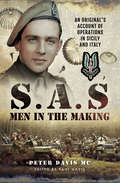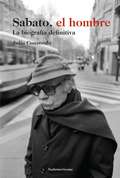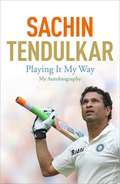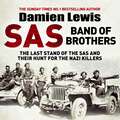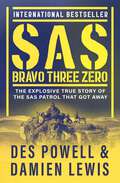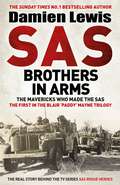- Table View
- List View
Rx for Adventure: The Story of an Alaska Bush Pilot Doctor
by Naomi Gaede-Penner Elmer GaedeAfter driving up the Alaska-Canada Highway with her family at age five, Naomi Gaede-Penner spent many of her formative years in the land of Indians and Eskimos, the Yukon River, tundra, dogsleds, the midnight sun and -70 degrees F. A lasting impression from those years is her father's suppertime storytelling. Those stories were about medical emergencies, bush flying hazards, and hunting adventures.
Ryan Adams: Losering, A Story of Whiskeytown (American Music Series)
by David MenconiBefore he achieved his dream of being an internationally known rock personality, Ryan Adams had a band in Raleigh, North Carolina. Whiskeytown led the wave of insurgent-country bands that came of age with No Depression magazine in the mid-1990s, and for many people it defined the era. Adams was an irrepressible character, one of the signature personalities of his generation, and as a singer-songwriter he blew people away with a mature talent that belied his youth. David Menconi witnessed most of Whiskeytown's rocket ride to fame as the music critic for the Raleigh News & Observer, and in Ryan Adams, he tells the inside story of the singer's remarkable rise from hardscrabble origins to success with Whiskeytown, as well as Adams's post-Whiskeytown self-reinvention as a solo act. Menconi draws on early interviews with Adams, conversations with people close to him, and Adams's extensive online postings to capture the creative ferment that produced some of Adams's best music, including the albums Strangers Almanac and Heartbreaker. He reveals that, from the start, Ryan Adams had an absolutely determined sense of purpose and unshakable confidence in his own worth. At the same time, his inability to hold anything back, whether emotions or torrents of songs, often made Adams his own worst enemy, and Menconi recalls the excesses that almost, but never quite, derailed his career. Ryan Adams is a fascinating, multifaceted portrait of the artist as a young man, almost famous and still inventing himself, writing songs in a blaze of passion.
Ryan Adams: Losering, a Story of Whiskeytown (American Music Series)
by David MenconiBefore he achieved his dream of being an internationally known rock personality, Ryan Adams had a band in Raleigh, North Carolina. Whiskeytown led the wave of insurgent-country bands that came of age with No Depression magazine in the mid-1990s, and for many people it defined the era. Adams was an irrepressible character, one of the signature personalities of his generation, and as a singer-songwriter he blew people away with a mature talent that belied his youth. David Menconi witnessed most of Whiskeytown’s rocket ride to fame as the music critic for the Raleigh News & Observer, and in Ryan Adams, he tells the inside story of the singer’s remarkable rise from hardscrabble origins to success with Whiskeytown, as well as Adams’s post-Whiskeytown self-reinvention as a solo act. Menconi draws on early interviews with Adams, conversations with people close to him, and Adams’s extensive online postings to capture the creative ferment that produced some of Adams’s best music, including the albums Strangers Almanac and Heartbreaker. He reveals that, from the start, Ryan Adams had an absolutely determined sense of purpose and unshakable confidence in his own worth. At the same time, his inability to hold anything back, whether emotions or torrents of songs, often made Adams his own worst enemy, and Menconi recalls the excesses that almost, but never quite, derailed his career. Ryan Adams is a fascinating, multifaceted portrait of the artist as a young man, almost famous and still inventing himself, writing songs in a blaze of passion.
Ryan Higa's How to Write Good
by Ryan Higa<P>An unconventional, irreverent, yet heartfelt memoir by Ryan Higa, one of the top creators on YouTube. With pictures! And illustrations! And, y'know, words. <P>I know you're used to seeing me on the Internet, but here I am, coming at you in book form. You might be asking yourself, A Book? You? Why? Great question! Why did I write a book? Listen, I'm as surprised about it as you are. But I have a story to tell that I believe will help inspire people who are going through tough times to not only persevere through those tough times but to excel in them. And I couldn't be the only YouTuber without a book, could I? <P>So, welcome to Ryan Higa's How to Write Good, by me, Ryan Higa. This is the story of how I went from being a relatively happy kid to being depressed and angry and filled with dark thoughts. This is the story of how I thought I had only one way out of this cruel world. This is the story of how I found a better way. But wait, there's more! <P>You're not only getting my story but you'll also learn how to write good--I mean well--from a college dropout who struggled in basic-level English classes and still became a legit, published Best Sailing Author. (That wasn't a typo. I plan to buy a boat one day...but probably not anytime soon. This book might not cell good.) <P><b>A New York Times Bestseller</b>
Ryan Higa's How to Write Good
by Ryan HigaAn unconventional, irreverent, yet heartfelt memoir by Ryan Higa, one of the top creators on YouTube. With pictures! And illustrations! And, y'know, words. Now a New York Times bestseller!I know you're used to seeing me on the Internet, but here I am, coming at you in book form. You might be asking yourself, A book? You? Why? Listen, I'm as surprised about it as you are. But I have a story to tell that I believe will help inspire people who are going through tough times. And I couldn't be the only YouTuber without a book, could I?This is the story of how I went from being a relatively happy kids to being depressed and angry and filled with dark thoughts. This is also the story of how I found my way to a happier life. But wait, there's more! You're not only getting my story but you'll also learn to write well, from a college dropout who struggled in basic-level English classes and still became a legit, Best Sailing Author. (That wasn't a typo. I plan to buy a boat one day...but probably not anytime soon. This book might not cell good.)
Ryan Pitts: Afghanistan: A Firefight in the Mountains of Wanat (Medal of Honor #2)
by Michael P. SpradlinStaff Sergeant Ryan M. Pitts enlisted in the Army when he was seventeen, and was just twenty-two years old when he fought at the Battle of Wanat in Afghanistan, where his heroic actions earned him the Congressional Medal of Honor. On July 13, 2008, Staff Sergeant Pitts was trapped and badly wounded at an elevated outpost, but helped turn back a brutal attack by 200 insurgents and save many of his company in one of the bloodiest battles of the war with Afghanistan.The Medal of Honor series profiles recipients of the highest and most prestigious personal military decoration, awarded to recognize U.S. military service members who have distinguished themselves through extraordinary acts of valor.
Ryan's Well (Fountas & Pinnell LLI Gold #Level N)
by Susan BuckleyRyan's Well Author: Susan Buckley
Ryanland: A no-frills odyssey across the new Europe
by Philip NolanIn this hilarious, no-holds-barred account, journalist Philip Nolan packs his bag (maximum 10kg, please) and takes us on an adventure that is not for the faint-hearted as he flies with Europe 's biggest low-cost airline. Using Ryanair destinations as a route planner, we grab our boarding passes and fight for the first available seat as we travel with him to towns we've never heard of ( Tampere and Wroclaw , anyone?) and to cities we've always wanted to visit. From watching the pilgrims completing the Camino in Santiago de Compostela to cheering with the fans in Frankfurt during the World Cup, from having his alpha waves channelled at a spa in Austria to a little soul cleansing at the baths at Lourdes, from the all-night party that is Riga to the eerie hush of Beauvais on a slow Monday night, we are treated to a kaleidoscopic snapshot of the quirks and foibles of a continent. Ryanair has opened up Europe 's treasures, and a few complete dumps too, in a way never before possible. From Biarritz to Blackpool to Bratislava , Pau to Pisa to Porto, Vienna to Valencia to Venice , Philip Nolan completes a whirlwind tour of the continent he calls Ryanland. The journey is whimsical, wistful and laugh-out-loud funny, as we travel on a spellbinding no-frills odyssey.
Ryanland: A no-frills odyssey across the new Europe
by Philip NolanIn this hilarious, no-holds-barred account, journalist Philip Nolan packs his bag (maximum 10kg, please) and takes us on an adventure that is not for the faint-hearted as he flies with Europe 's biggest low-cost airline.
Ryszard Kapuscinski
by Artur DomoslawskiReporting from such varied locations as postcolonial Africa, revolutionary Iran, the military dictatorships of Latin America and Soviet Russia, the Polish journalist and writer Ryszard Kapu?ci?ski was one of the most influential eyewitness journalists of the twentieth century. During the Cold War, he was a dauntless investigator as well as a towering literary talent, and books such as The Emperor and Travels with Herodotus founded the new genre of 'literary reportage'. It was an achievement that brought him global renown, not to mention the uninvited attentions of the CIA.In this definitive biography, Artur Domos?awski shines a new light on the personal relationships of this intensely charismatic, deeply private man, examining the intractable issue at the heart of Kapu?ci?ski's life and work: the relationship and tension between journalism and literature.In researching this book, Domos?awski, himself an award-winning foreign correspondent, enjoyed unprecedented access to Kapu?ci?ski's private papers. The result traces his mentor's footsteps through Africa and Latin America, delves into files and archives that Kapu?ci?ski himself examined, and records conversations with the people that he talked to in the course of his own investigations. Ryszard Kapu?ci?ski is a meticulous, riveting portrait of a complex man of intense curiosity living at the heart of dangerous times.
Ryszard Kapuściński: Biography of a Writer
by Beata Nowacka Zygmunt ZiątekAn award-winning writer and a candidate for the Nobel Prize for Literature, Ryszard Kapuściński (1932–2007) was a celebrated Polish journalist and author. Praised for the lengths to which he would go to get a story, Kapuściński gained an extraordinary knowledge of the major global events of the second half of the twentieth century and shared it with his diverse audience.The first posthumous monograph on the writer’s life and work, Ryszard Kapuściński confronts the mixed reception of Kapuściński’s tendency to merge the conventions of reportage with the artistry of literature. Beata Nowacka and Zygmunt Ziątek discuss the writer’s accounts of the decolonization of Africa and his work in Asia and South America between 1956 and 1981, a period during which Kapuściński reported on twenty-seven revolutions and coups. They argue that the journalistic tradition is not in conflict with Kapuściński’s meditations on the deep meanings of these events, and that his first-person involvement in his text was not an indulgence detracting from his journalistic adventures but a well-thought-out conception of eyewitness testimony, developing the moral and philosophical message of the stories. Exploring the whole of Kapuściński’s achievements, Nowacka and Ziątek identify a constant tension between a strictly journalistic position and what in Poland is called literary reportage, located on the border between journalism and artistic prose. Kapuściński’s desire and dedication to make more of journalistic writing is the driving force behind the excellence and readability that have made his legendary books so controversial – and so widely celebrated.
Rywka's Diary: The Writings of a Jewish Girl from the Lodz Ghetto
by Anita Friedman"A work of elegant translation and painstaking contextualization by Holocaust scholars and surviving family members that sharpens the historical and spiritual lens through which it's absorbed." —Chicago TribuneThe newly discovered diary of a Polish teenager in the Lodz ghetto during World War II—originally published by Jewish Family & Children’s Services of San Francisco, now revised, illustrated, and beautifully designedAfter more than seventy years in obscurity, the diary of a teenage girl during the Holocaust has been revealed for the first time. Rywka’s Diary is at once an astonishing historical document and a moving tribute to the many ordinary people whose lives were forever altered by the Holocaust. At its heart, it is the diary of a girl named Rywka Lipszyc who detailed the brutal conditions that Jews in the Lodz ghetto, the second largest in Poland, endured under the Nazis: poverty, hunger and malnutrition, religious oppression, and, in Rywka’s case, the death of her parents and siblings. Handwritten in a school notebook between October 1943 and April 1944, the diary ends literally in mid-sentence. What became of Rywka is a mystery. A Red Army doctor found her notebook in Auschwitz after its liberation in 1945 and took it back with her to the Soviet Union.Rywka’s Diary is also a moving coming-of-age story, in which a young woman expresses her curiosity about the world and her place in it and reflects on her relationship with God—a remarkable affirmation of her commitment to Judaism and her faith in humanity. Interwoven into this carefully translated diary are photographs, news clippings, maps, and commentary from Holocaust scholars and the girl’s surviving relatives, which provide an in-depth picture of both the conditions of Rywka's life and the mysterious end to her diary.Moving and illuminating, told by a brave young girl whose strong and charismatic voice speaks for millions, Rywka’s Diary is an extraordinary addition to the history of the Holocaust and World War II.
S. N. Goenka: Emissary of Insight (Lives of the Masters #5)
by Daniel Stuart S. N. GoenkaIn a life that saw him evolve from a staunchly religious Hindu to an ecumenical master of Buddhist insight meditation, Satyanārāyaṇ (S. N.) Goenka (1924–2013) emerged as a leader in the spread of lay mindfulness and insight meditation practice on a global scale. A second-generation Burmese of Indian origin, Goenka was a successful businessman before turning to Buddhist meditation for help with crippling migraines. Becoming first a close student and then assistant teacher under the innovative Burmese lay Buddhist teacher U Ba Khin, Goenka eventually felt the pull of karmic destiny to teach meditation in India and thereby repay the ancient debt that Burmese Buddhists owed to the original Indian Buddhist tradition. In the 1970s, as he became an integral part of the Indian Buddhist spiritual landscape, thousands of young people from the United States and Europe flocked to India to explore its spiritual possibilities. Out of this remarkable convergence was launched a global network of practitioners and meditation centers that would become Goenka&’s legacy.Drawing heavily on Goenka&’s own autobiographical writings and Dharma talks, Daniel Stuart draws the first comprehensive portrait of the master&’s life and demonstrates that Goenka&’s influences, teaching, and legacy are much more complex than has been commonly thought. Stuart incorporates a wide range of primary documents and newly translated material in Hindi and Burmese to offer readers an in-depth exploration of Goenka&’s teachings and his practice lineage in Burma. Stuart further details the trials and tribulations Goenka faced in building a movement in India in the 1970s, developing a global network of meditation centers, and negotiating a range of relationships with students and religious leaders worldwide. This fascinating addition to the Lives of the Masters series reflects on Goenka&’s role in the revival of Buddhism in postcolonial India and his emergence as one of the most influential meditation masters of the twentieth century.
S. Weir Mitchell, 1829–1914: Philadelphia's Literary Physician
by Nancy CervettiThis modern biography provides a comprehensive and balanced view of a legendary figure in American medicine. Controversial because of his fierce fight against women’s rights, S. Weir Mitchell achieved stunning success through his experimentation with venomous snakes, treatment of Civil War soldiers with phantom limbs and burning pain, and creation of the rest cure to treat hysteria and neurasthenia. Mitchell’s life was extraordinary—interesting in its own right and as a case study in the larger inquiry into nineteenth-century medicine and culture.
S.A.S Men in the Making: An Original's Account of Operations in Sicily and Italy
by Peter DavisPeter Davis was the youngest officer in the SAS during World War II. In his autobiographical account, he reveals the nave enthusiasm he felt when he joined the Unit, his fears and trepidation during training, and the horror at what he later experienced during his first operations in the liberation of Sicily and Italy. This is his story.It explores the difficulty of a young, inexperienced officer leading older and seasoned soldiers. It tells of mistakes a 'rookie' can make and of how listening, learning and ultimately earning respect made him the skilful leader he ultimately became. During later operations he was awarded the Military Cross.Through it all the enigmatic figure of Paddy Mayne looms large. At times irrational, aggressive, and often drunk, he was always a born leader able to instil obedience and respect. Where he led, men followed.This autobiographical account was written shortly after the end of the War, using diaries written at the time. It is possibly the last, untold, first-hand account of a time of chaos, of horror and of the camaraderie of the men of the SAS.
S.O.S. Spirit Of Survival: One Family's Chilling Account of the Costa Concordia Disaster
by Ananias Family"S. O. S. : Spirit of Survival" is a one-of-a-kind story of the incredible fortitude that ordinary people can conjure in order to overcome even the most harrowing of disasters. Told from the point of view of each of the five members of one family, this book offers a unique and detailed look into the truth behind the headlines surrounding the Carnival Cruise Lines Costa Concordia cruise ship sinking off the coast of Isola del Giglio, Tuscany in January of 2012. Their astounding account of the tragic events before, during and, perhaps most shockingly, after the enormous cruise ship ran aground are sure to amaze readers. However, the true messages of this book are hope and profound inspiration, as this familys bond deepens and strengthens through their ultimate survival journey.
SABATO, EL HOMBRE (EBOOK)
by Julia J. Constenla"Quiero destacar lo inesperado y grato que ha sido para mí leer el libro de Julia Constenla. Estas páginas recuperan, sin grandilocuencia, los acontecimientos más trascendentes de la vida de Sabato, pero también muestran, con valor y equilibrio, los momentos más difíciles y las decisiones menos afortunadas. Matilde y Ernesto están aquí tal como son y es imposible no quererlos. La autora ha querido compartir con usted el maravilloso misterio de su humanidad."Monseñor Justo Laguna A diez años de su primera edición, Julia Constenla vuelve sobre esta ya clásica biografía de Ernesto Sabato para darle su forma definitiva. Retoma también esa mirada cálida y profunda sobre la vida del escritor en su aspecto más humano, desde la posición privilegiada de su amistad, pero también como testigo lúcida de más de cincuenta años compartidos. El resultado es este libro maravilloso, indispensable tanto para sus lectores como para quienes se asomen a su obra por primera vez y deseen aprehenderla desde su propio mundo, a veces tan público, otras tan privado. "A comienzos de la década del cincuenta quise dejar en claro lo que pensaba sobre algunos temas que todavía hoy me acosan. Entonces publiqué Hombres y engranajes. Son mis reflexiones sobre la crisis de nuestro tiempo, después de medio siglo todavía sigo creyendo lo que creía entonces. En mis novelas dije todo lo que tenía que decir sobre el amor, la furia, el dolor, la muerte, Dios. Ya lo he dicho todo, me parece justo y necesario llamarme a silencio." Ernesto Sabato
SACHIN TENDULKAR Playing It My Way,My Autobiography
by Sachin Tendulkar Boria MajumdarIn his autobiography Sachin Tendulkar recounts and shares about the defining moments of his passionate cricket career, his family,his captaincy,his team-mates and about some interesting facts like what goes on in the minds of a player before the match,in the dressing room, during the match and also on his love for food and music.
SAP's CEO on Being the American Head of a German Multinational
by Bill Mcdermott"Today I’m the chief executive of SAP, which is headquartered in Walldorf, Germany. The company was founded by five engineers who would build SAP into a market-leading business software maker and a crown jewel in Germany’s strong economy. I’m the first American to lead SAP in its 45-year history. I’m also the only American-born CEO leading a company on the DAX, Germany’s stock exchange. I’m the only American on the European Round Table of Industrialists, a group of CEOs of Europe’s largest companies. With a presence in nearly every country on earth, SAP has long been open to contributions by anyone, of no matter what nationality or background. Still, leading a company whose identity is rooted in a culture that’s foreign presents unique challenges—which is why few CEOs do it."
SARMIENTO PERIODISTA (EBOOK)
by Valenzuela-SanguinetSarmiento fue periodista, quizás, antes que cualquier otra cosa. Cuando aún no existía un campo periodístico independiente y profesional, ejerció el oficio con pasión, desde su nacimiento a la vida pública hasta su muerte. Libró en este ámbito batallas ideológicas y políticas, y se construyó a sí mismo en la prensa. A diferencia de otros hombres ilustres de su época, como Alsina o Mitre, él no tenía un #aparato# ni una experiencia partidaria o militar que lo pusieran en la lista de los presidenciables. Consiguió ese lugar a fuerza de escribir y polemizar. La pluma y el periódico fueron su partido. Sus mejores textos fueron consecuencia de sus luchas. El Facundo, libro fundacional de la literatura argentina, se publicó originalmente como folletín, con la urgencia de su contienda propagandística contra el régimen rosista. Su estilo como escritor lleva la marca inconfundible de su carácter periodístico: audaz, práctico, punzante, siempre en busca del centro del ring para ganar la polémica. Diego Valenzuela y Mercedes Sanguineti reconstruyen en estas páginas, con materiales y documentos inéditos, el peculiar e intenso itinerario del Sarmiento periodista, iluminando una faceta poco investigada de este personaje ineludible de la historia argentina. Durante su campaña con el Ejército Grande, se definió a sí mismo como #soldado con la pluma o con la espada, combato para poder escribir, que escribir es pensar#. Alberdi le reprochó que #en sus manos, la pluma fue una espada y no una antorcha#, y lo bautizó #el caudillo de la pluma#.
SAS Band of Brothers
by Damien LewisThe new SAS epic from bestselling military historian Damien LewisWe share the triumphs and tragedies of a group of elite soldier trailblazers as they commit daring raids behind enemy lines in 1944, manage an against the odds escape to victory, and then seek post-war retribution for the terrible murder of their captured comrades.SAS BAND OF BROTHERS is replete with action, peppered with great characters, and features two of the most daring escapes of WWII. It ends with the hunted becoming the hunters - a group of men intent on seeking out the Nazis responsible for their brethren's deaths, on an ultra-deniable SAS mission to avenge a war crime.This is the new bestseller from Damien Lewis. It bears all his hallmarks - an epic, page-turning special forces narrative based on hitherto unavailable personal testimony and private family archives.(P)2020 Quercus Editions Limited
SAS Bravo Three Zero: The Explosive True Story of the SAS Patrol That Got Away
by Damien Lewis Des PowellThe untold story of an elite SAS patrol behind enemy lines during the Persian Gulf War is vividly revealed in this gripping chronicle.Iraq, January, 1991. Three patrols—Bravo One Zero, Bravo Two Zero, and Bravo Three Zero—were flown deep behind enemy lines to hunt down Saddam&’s Scud missiles, the use of which threatened a third World War. The men of Bravo One Zero saw the flat desert devoid of cover and decided not to deploy. When Andy McNab&’s famed Bravo Two Zero patrol did deploy, the results were tragic—all but one was captured or killed. Then there was Bravo Three Zero. Deploying despite the lack of cover, they could make a dash for the border if desperate. Even as warnings came in that McNab&’s patrol was on the run, Bravo Three Zero continued undetected—becoming the Coalition forces furthest behind Iraqi lines and taking out a string of targets along the way. But with the desert turning bitter and snow starting to fall, they were forced to fight a running battle against the elements as much as the adversary. The achievements of the highly decorated Bravo Three Zero are the stuff of elite forces legend. Now, for the first time, SAS veteran Des Powell reveals their story in gritty, blow-by-blow detail. Written alongside acclaimed military author Damien Lewis, this is a tale of daring deep inside enemy lands.
SAS Brothers in Arms: Churchill's Desperadoes: Blood-and-Guts Defiance at Britain's Darkest Hour.
by Damien LewisDamien Lewis's new bestseller tells the action-packed, riveting story of the band of mavericks and visionaries who made the SAS. Using hitherto untold stories and new archival sources, Damien Lewis follows one close-knit band of warriors from the SAS foundation through to the Italian landings - chronicling the extraordinary part they played as the tide of the Second World War truly turned in the Allied's favour. This is a narrative of wall-to-wall do-or-die action and daring, chronicling the exploits of some of the most highly-decorated soldiers of the twentieth-century.

